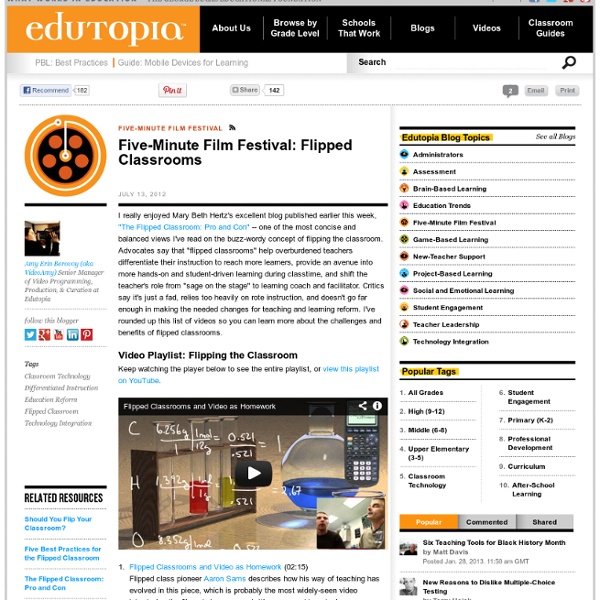The Flipped Classroom | Quiet Working Mouse No. 79
Long sleeve structured blazer in baby blue. Stand collar. Open front with single post stud closure at waistband. Lightly padded shoulders. Fully lined. Tonal stitching.
10 TED Talks That Could Be Used As Course Titles
I was perusing my morning Twitter stream and came across a few friends discussing the current state of course titles. Long story short, most are still stuck in the dark ages. Biology 101? World History 1812-Present? In this day and age of short attention spans, flipping of classrooms, and rethinking of education… it’s time to rethink course titles. In an effort to give school administrators and teachers a guidepost with which they can rethink current course titles (what better time than in July, right?) In other words, make the course titles sexier, the descriptions more attractive, and get students excited to attend a class before they even step foot in the classroom for the first time. So, without further ado, here are potential course titles that are actual TED talks / TED categories. Inventions That Shape History (Could be a course on world history or even engineering / physics.) The Way We Think (Could be a course on sociology, anthropology, philosophy, Kant, Sartre, etc.)
Khan Academy
The Flipped Classroom is not… | Quiet Working Mouse No. 79
Long sleeve structured blazer in baby blue. Stand collar. Open front with single post stud closure at waistband. Lightly padded shoulders. Fully lined.
User Generated Education
Beyond Substitution: The SAMR Model « 2011 Summer Tech Institute
Think technology and education end with Word documents and Google Apps? Think again. SAMR, a model designed to help educators integrate technology into teaching and learning , was developed by Dr. Double click the image below to get a full size view of the image. Substitute, Augmentation, Modification, Redefinition SAMR - Models for Enhancng Technology Integration 1 The four levels of the SAMR model: 1. 2. 3. 4. Find more information about SAMR in Puentedura’s podcasts at iTunes U. Like this: Like Loading...
The Flipped Classroom - FacultyRow
Faculty Row The Official Home Of America's Top Faculty™ The Flipped Classroom With the teacher at the front and seats in rows, the classroom has barely changed in the last century. But, we now know that there's no "one size fits all" a... Rating: Share Twitter Facebook Views: 100 Get Embed Code Tags: animation, classroom, faculty, flipped, professors, More… Related Videos Comment You need to be a member of Faculty Row to add comments! Join Faculty Row Welcome toFaculty Row Quick Sign Upor Sign In Or sign in with: NYTimes Higher Ed (CLICK) Badge Get Badge Top Content Chair/Reader/Senior Lecturer in Educational Leadership and Management - (Associate Professor) Professor and Executive Director Research Professor and Executive Director Professor and Head of the Claude Littner Business School Chair of Neurosurgery, Head of the Division of Neurosurgery and Honorary Consultant Neurosurgeon Professor and Head, School of Arts and Social Sciences Associate Professor and Director of the MA Social Work (55126-044) More…
The Flipped Classroom: A Pedagogy for Differentiating Instruction and Teaching Essential Skills
July 31, 2012 by Scott Sterling Summer is almost over and some educators, when thinking about the upcoming school year, may be considering “flipping their classroom” as a new method for instruction of essential skills. A flipped classroom is one in which the background learning of a particular topic or skill occurs outside of class time - utilizing technological tools like videos and podcasts to teach the essential skills. This leaves class time free to work collaboratively on the higher-order thinking needed to utilize these skills. In other words, class time is now free to spend working with the students because everyone has already received the background instruction that takes up so much time in the traditional classroom. For example, let’s say you are teaching the Pythagorean theorem. The students are instructed to watch the instructional video and then post one question about the theorem on your online classroom message board. For further reading: Related reading :
Episode 14 Podcast - "The Flipped Classroom"
The State of Tech - Episode 14 - "The Flipped Classroom" Summary: In this episode we talk about the flipped classroom. We define what "flipping" your classroom is and is not, explore how to integrate the concepts behind the flipped classroom model into your curriculum, and how to leverage available technology to appropriately pair the learning activity with the learning environment. Guests also discuss their success stories, tips and tricks, tools, and hurdles they faced when flipping their own classrooms. Watch Video Episode Online: Subscribe to Video Podcast Download Video Embed Video Listen to Audio Episode Online: Subscribe to Audio Podcast Download Audio Embed Audio Show Notes (click "Read more" to see full show notes if they are not already displayed below.)Hosts Main Topic: The Flipped Classroom Useful Links Tools available for creating annotated screencasts and tutorials: * Survey is still open for Teaching Science with Technology: Link
Flipped Classroom: Beyond the Videos
Last week, I read an interesting blog post by Shelley Blake-Plock titled “The Problem with TED ed.” It got me thinking about the flipped classroom model and how it is being defined. As a blended learning enthusiast, I have played with the flipped classroom model, seen presentations by inspiring educators who flip their classrooms, and even have a chapter dedicated to this topic in my book. There are many teachers who do not want to record videos either because they don’t have the necessary skills or equipment, their classes don’t include a lot of lecture that can be captured in recordings, or they are camera shy. Too often the conversation surrounding the flipped classroom focuses on the videos- creating them, hosting them, and assessing student understanding of the content via simple questions or summary assignments. I wish the conversation focused more on what actually happens in a flipped classroom. Blake-Plock makes a strong point when he says we learn by “doing.” 1. 2. 3.



